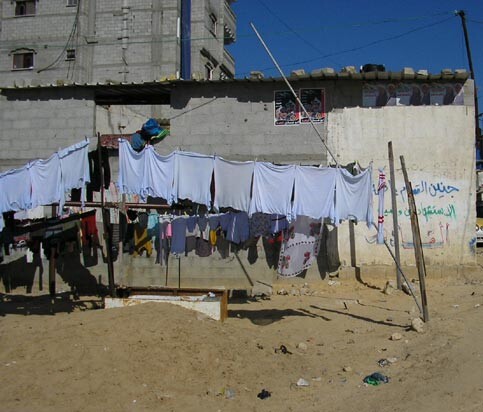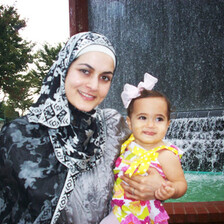Khan Younis, Palestine 28 June 2005

Laundry in Khan Yunis refugee camp. (Arjan El Fassed)
It’s interesting to read the news from this perspective. I mean, when you are the news, or when you are living the news that is being reported, and while all the while you write the news.
On Monday I visited the Khan Yunis refugee camp, the target of many an attack by Israeli forces, to talk to Palestinian refugees there, to hear their thoughts on Israeli disengagement (the subject of a forthcoming article).
It was quite an incongruous-and bleak-scene, as is often the case in Gaza. Crumbling refugee homes with pockmarks the size of apples stand like carcasses in front of the Neve Dekalim settlement, part of the Gush settlement bloc. It is shaded with palm trees, red-roofed Mediterranean style villas, and the unspoilt pristine sands of the Khan Yunis beach, accessible to all but the Palestinians now.
Abo Ahmed is one of the refugees I met. The view from the second floor of his home on the edge of the camp overlooking Neve Dekalim, and an Israeli sniper tower, is breathtaking. The military base aside, there is nothing but the clear blue of the lonely Khan Yunis Mediterranean. “Nice view, right?” he told me jokingly, the wall behind him pockmarked like a piece of Swiss cheese from the hundreds of Israeli shells and bullets that have hit it. “One of those holes could have been in me”. It’s was the first time Abo Ahmed had ventured up to this empty living room since he built it a few years ago.
His neighbours children, living under a zinc-sheet covered with torn blankets, giggled when they saw me. “Please take our picture” asked a little girl, Siham.
Overhead, a drone whirred menacingly, and a helicopter gunship cruised the coast. “See those planes, they come and shoot missiles at us,” they explained expertly. Planes they have seen too many times before. War has been their teacher.
Nearby, a group of Palestinians who live in the Mawasi enclave-completed sealed off from the rest of Gaza by Israeli forces for several years now- sat under a the shade of a handmade palm-leaf canopy waiting for the Tufah checkpoint to open, so they could return home. A day before, 4 of Mawasi’s residents were brutally beaten by Jewish settlers form the Gush bloc. The perpetrators have yet to be brought to justice.
Meanwhile, the children trotted off into the horizon, dangerously close to the Israeli sniper tower, trying to fly a rustic paper kite one of the older boys folded together.
Next to them, a group of boys cooled off in a pool of salty wastewater that pours into a sand pit here from the settlements, the byproduct of an Israeli desalination plant. This is their playground. Soon, the Israelis call the Palestinian DCO to ward them off.
On my way back to Gaza city, I learn that 17-year-old Iyad al-Nabaheen was shot dead by Israeli snipers as he was catching birds with his friend north of the Breij refugee camp, just as I pass by it. I couldn’t help but think that could have been little Siham. Or one of the other children wading in the water. Or my own son, Yousuf.
But Iyad’s death didn’t make it anywhere. His obituary could be found in the 7th or 8th paragraph of an article talking about an attempted-even fabricated some say- female suicide bombing at Erez, and the killing of an Israeli settler in the West Bank. Rest in peace, Iyad. May your soul fly higher than little Siham’s kite.
Leila M. El-Haddad is a journalist based in the Gaza Strip.





